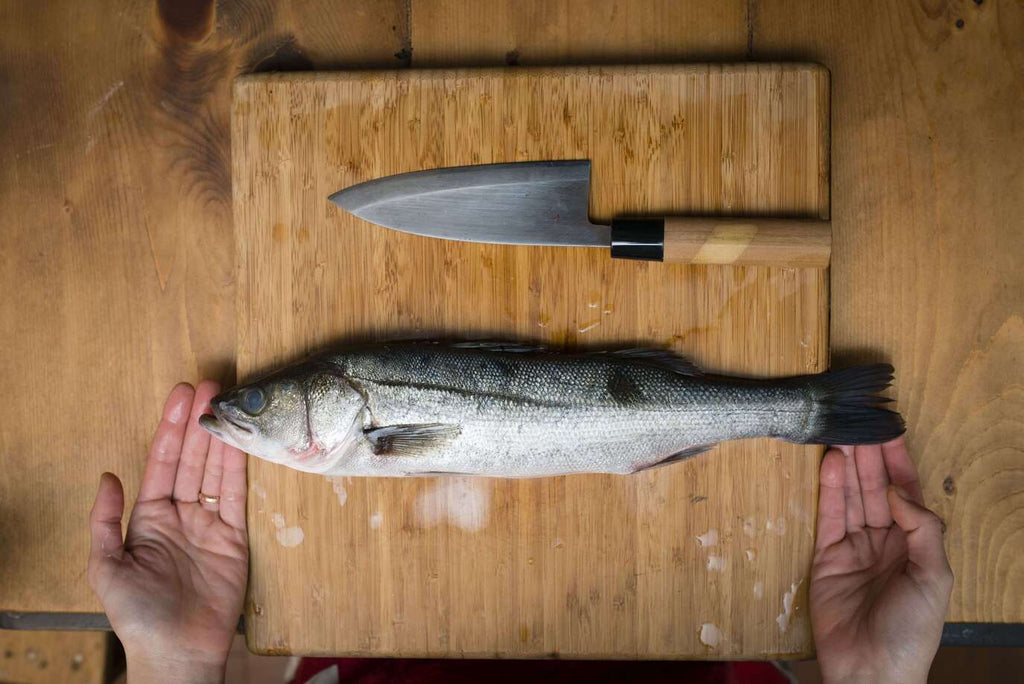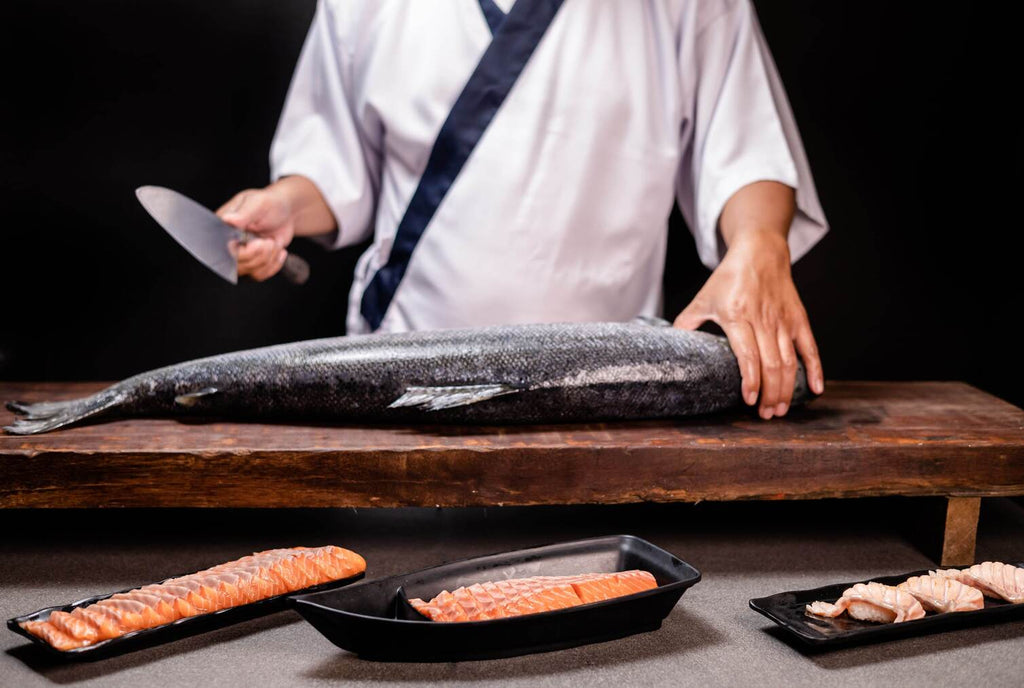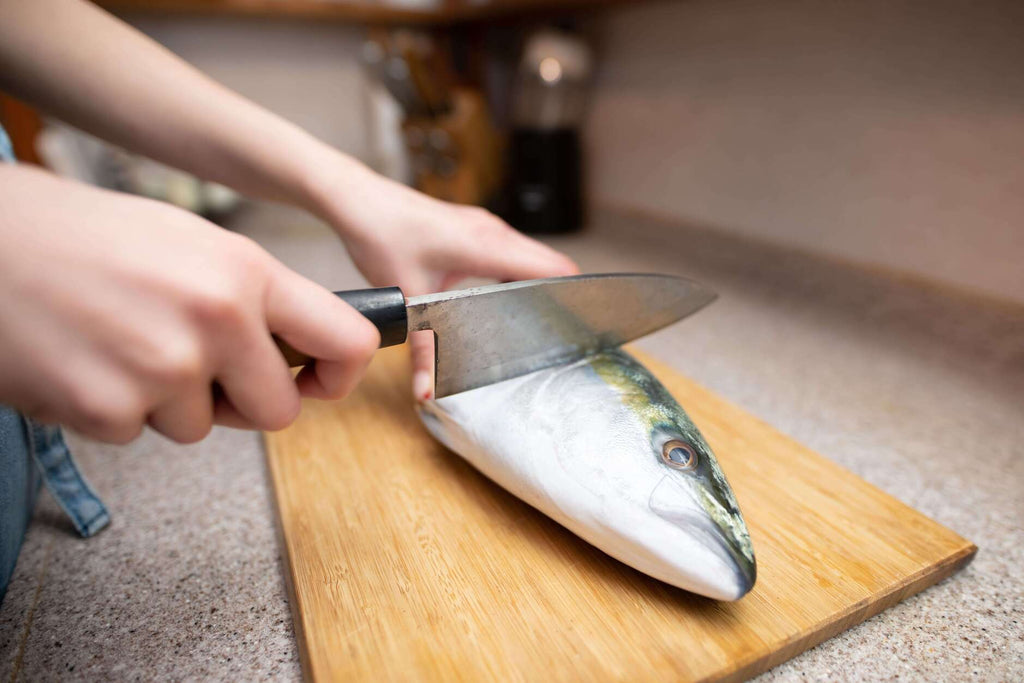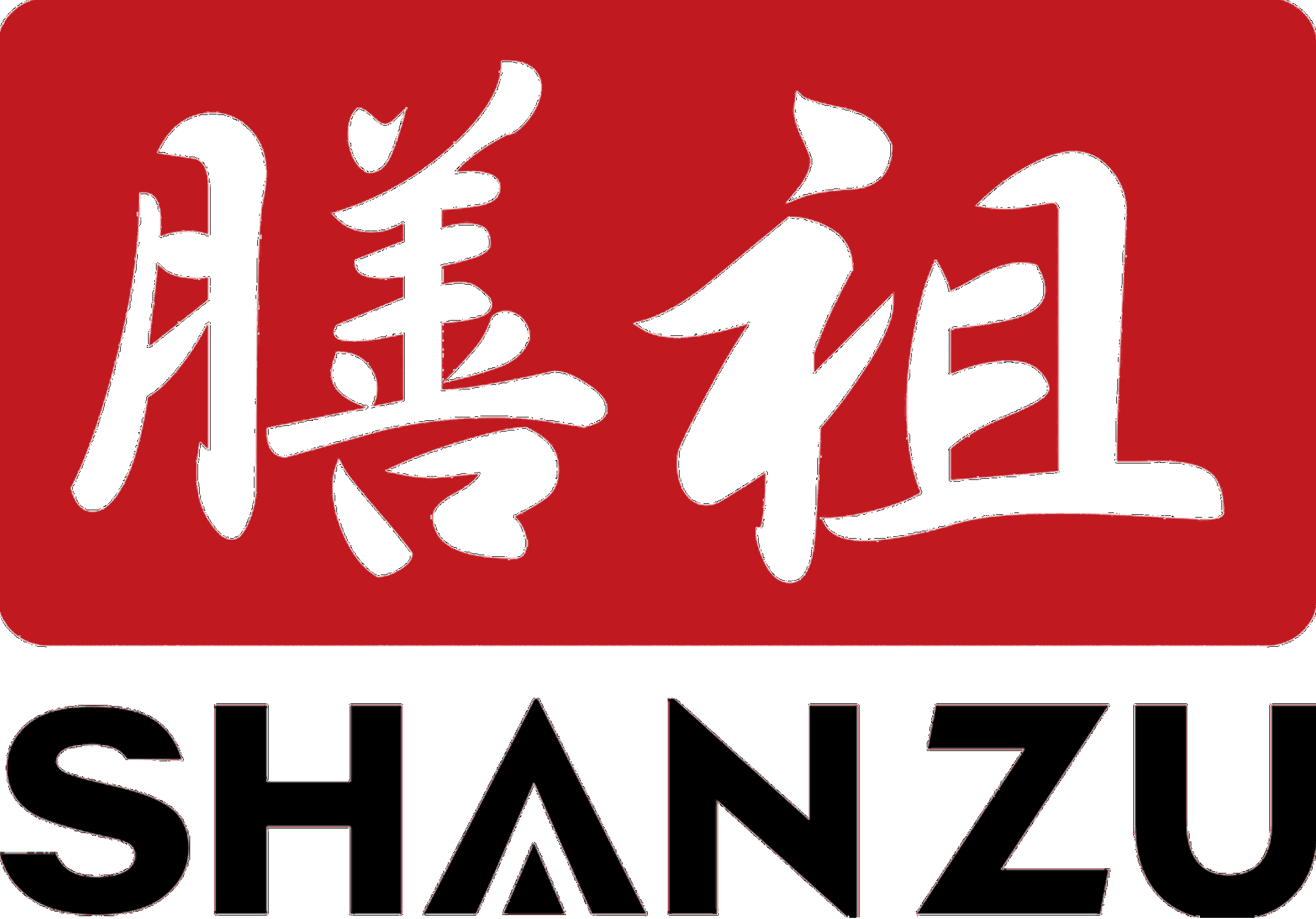- What is a Deba?
- The Deba Profile
- Deba Historical
- A Deba in Detail
- The Shape
- The Center of Gravity
- The Sharpness
- The Handle
- The Deba at Work - How to Use It
- The Deba Blade: Material and Structure
- Carbon Steel
- Stainless Steel
- Damascus Steel
- Deba Care, Storage, and Sharpening
- Deba Purchase Criteria Summary
What is a Deba?

The Deba knife is a traditional Japanese kitchen knife with a unique design and purpose. It is a single-beveled knife with a thick, heavy blade that is used to slice and fillet fish. Unlike other kitchen knives, the Deba knife is specifically designed to cut through the heads and bones of fish, making it an essential tool for Japanese chefs who specialize in preparing seafood dishes. This powerful specialist for cutting fish and meat is often found in Japan's traditional kitchens or at fish and meat markets. In Europe, the knives reminiscent of a santoku or short Gyuto are rather unknown. Additionally, the Deba knife’s thick blade is also suitable for cutting through meat, poultry, and soft vegetables like tomatoes and cucumbers. However, for those who have already learned to appreciate the legendary knife steels from Nippon and exten
The Deba Profile
- Primarily for cutting fish and meat
- Blade shape similar to the Santoku
- Blade length between 12 and 30 centimeters, typically 15 to 18 centimeters
- Blade thickness up to 6 millimeters, therefore also heavy
- One-sided bevel, right or left
- Classic ferrule made of buffalo horn to hold the blade in place
- Usual: magnolia wood handle, with an oval or chestnut cross-section
Deba Historical

The Deba (Japanese for "pointed carving knife") is one of the oldest kitchen knives from Japan. It originated around 1700 in Sakai, the great trading and port city of Osaka - and the center of samurai swordsmiths, which gradually became civilian. The Deba knife’s design is the result of centuries of refinement by Japanese chefs and blacksmiths, and its shape and structure have remained largely unchanged for centuries. Even then, Sakai held a monopoly with regional trademark rights for knife making, and its Deba was regarded in the blacksmithing metropolis as teaching pieces for young blacksmiths. Even today, each of Sakai's remaining factories cultivates its type and production mode of exquisite Deba knives. With fixed traditional rituals, procedures, and recipes - and signature of the best specimens by hand, which at that time was also adopted for swords. Legendary even for Japan is their extraordinary, mostly multi-layered steels and unusual sharpness, which make connoisseurs' hearts leap for joy despite four-digit euro prices.

A Deba in Detail
The Shape
The Deba knife could pass for a cross between a cleaver and a Santoku knife. In side elevation, the blade is very high, the cutting edge slightly curved, while the strong spine only tapers to a blunt-angled point at the end with the bevel. The length of a Deba can vary somewhat to accommodate different-sized cutting objects. In Japanese cuisine, there are many different sizes and species of seafood, so there are many different types and sizes available. Its strength in the back of the blade is equal to that of a European cleaver.
The Center of Gravity
The higher weight of the Deba makes it clear that Japanese knives have their center of gravity in the rear third of the blade, not between the blade and the handle, as is the case with European knives. With this weight distribution, the Deba supports you when cutting large material, but also carries the risk that it can slip out of your hand and land tip first.
The Sharpness
The secret of the Deba's extreme sharpness despite its strong blade is not only in the material but in the grinding. Deba knives are always sharpened very steeply and highly on one side only. This predestines them for the most precise straight and thin cuts, whereby the opposite side of the blade always has a slight hollow grind. In this way, forging artists reduce sticking to the material to be cut, friction during cutting, and the amount of force required. However, handling it is unfamiliar at first.
The Handle
Japanese cleavers made in the traditional manner hold the solid blade via a buffalo horn ferrule seamlessly on a wooden Wa-handle. High-quality resin or special plastics can be a viable buffalo horn substitute, cheap plastic never can. Meanwhile, Debas with classic European handles in ergonomic shapes is also available. With the straight Japanese handles, an oval cross-section is standard. Longitudinal edges often improve the grip in the vertical: With the chestnut shape, it is one, with hexagonal or octagonal handles it is several.
The Deba at Work - How to Use It

The very important thing for Europeans with Deba in hand is to realize that this Japanese cleaver is not made for chopping, as we do. Neither the handle construction nor the thinly ground edge will tolerate the force of an axe blow. When it comes to backbones or bones, the back of the knife is used as a breaking tool. The tip is ideal for scaling, skinning, and carving out fine fillets. The one-sided grind produces super-smooth surfaces but requires a bit of practice at first. At Japanese fish markets, the Deba is the most widely used tool and the virtuoso actors there use it to prepare complete fish bite-sized in no time at all! Of course, the Deba knife is an essential tool for any chef who specializes in preparing seafood dishes. Its thick, heavy blade is designed to quickly and easily slice through fish, as well as to fillet them with precision. The Deba knife is also a very versatile tool, as its design allows it to be used to cut through meat, poultry, and soft vegetables. Furthermore, the Deba knife’s unique design makes it a great tool for making sushi, as its thick blade can easily slice through the ingredients without crushing them. A great Deba knife can do a lot more: from cutting capital pumpkins, boning and portioning tender beef and poultry to chopping delicate radish leaves and weighing herbs. Nevertheless, it is not a universal knife, thanks to its weight and its bevel.
The Deba Blade: Material and Structure
The solid blade of a Japanese cleaver is where the steel properties, forging, and hardening skills as well as the sharpening come into their own. Maximum sharpness must be combined with robustness and durability. Authentic Debas either have a heart of the best carbon steel in categories ranging from Shirogami to Aogami or are forged together from two to many layers of carbon steel with softer iron or alloy steel. More modern products offer good alternatives with stainless mono steels.
Carbon Steel
Advantages: achieves the highest hardness (HRC 63 to 66), thus also maximum sharpness and edge retention at prices that are reasonable. Disadvantages: susceptible to corrosion and breakage, therefore needs much care and maintenance (oil). Impacts, lateral stress, and hardness will inevitably cause damage to the point of ruining the beautiful piece. Suitable for you if you are looking for an authentic Japanese Deba with a patina and long-lasting super sharp edge, to which you like to devote some effort. "Good choice for professional chefs and enthusiastic home cooks.”
Stainless Steel
Advantages: The softer material is rust-resistant and flexible-elastic, may partly even be in the dishwasher, and is also otherwise undemanding at a reasonable price. Disadvantages: creates good, but not a dream sharpness and calls more often for the grindstone. Suitable for you if the Deba knife is new to you, you need it only occasionally or place more value on toughness than on the last bit of sharpness. " Suitable for the recreational to the professional chef.”
Damascus Steel
Advantages: In the best sense of the word, diverse alternating layers of hard and soft steel types distribute their best properties over the entire blade. Wild Damascus is for many not only functional but also aesthetically the crowning glory of Japanese knife making. Disadvantages: The knives for more than a lifetime have their price, which not everyone sees justified in the plus in cutting properties. And beware not everything that calls itself Damascus is actually hand-forged. Suitable for you, if you are ready for the highest quality of all Deba to reach deeper into the pocket and there is nothing more beautiful for you than a shimmering Damascus knife. "Dream of every knife collection of enthusiasts in professional and private kitchens.”
Deba Care, Storage, and Sharpening
Always cut on a wooden or plastic board, never solid hard, and above all: leave axe strokes. Non-stainless steels do not rinse the aggressive machine, but you by hand directly after use, if you want to work with it for a long time. Then dry and lightly oil, traditionally camellia oil is recommended. Some inox steels are exceptionally allowed in the dishwasher. Also, remember to oil wooden handles from time to time. For resharpening at home, you will definitely need a wet grindstone, because the Deba is honed on the honed side. The opposite side is only slightly deburred. The Deba may only be stored in a drawer in a shock-protected manner, for example in its original box. Alternatively, appropriately sized knife blocks or magnetic strips can be used.
Deba Purchase Criteria Summary
In conclusion, the Deba knife is an essential tool for any Japanese chef who specializes in preparing seafood dishes. Its unique design and construction make it a very versatile tool, as it can be used to cut through fish, meat, poultry, and soft vegetables. Furthermore, the Deba knife’s thick, heavy blade is designed to quickly and easily slice through fish, as well as to fillet them with precision: you won't need another knife. The Japanese cleaver is powerful and should fit your hand exactly in length, weight, material, and shape of the handle, so test its handiness. Think carefully about which material is best suited to your applications, requirements, and financial possibilities: super-sharp, sensitive carbon steel, frugal stainless steel, exquisitely layered steel, or premium Damascus. Beautiful looks alone are of little use in the kitchen. Great materials are important, but they do not make a high-quality, durable knife. Therefore, look closely and pay attention to proper workmanship. Study real reviews, check the information or trust producers with a good name and reputation, then you invest correctly.



